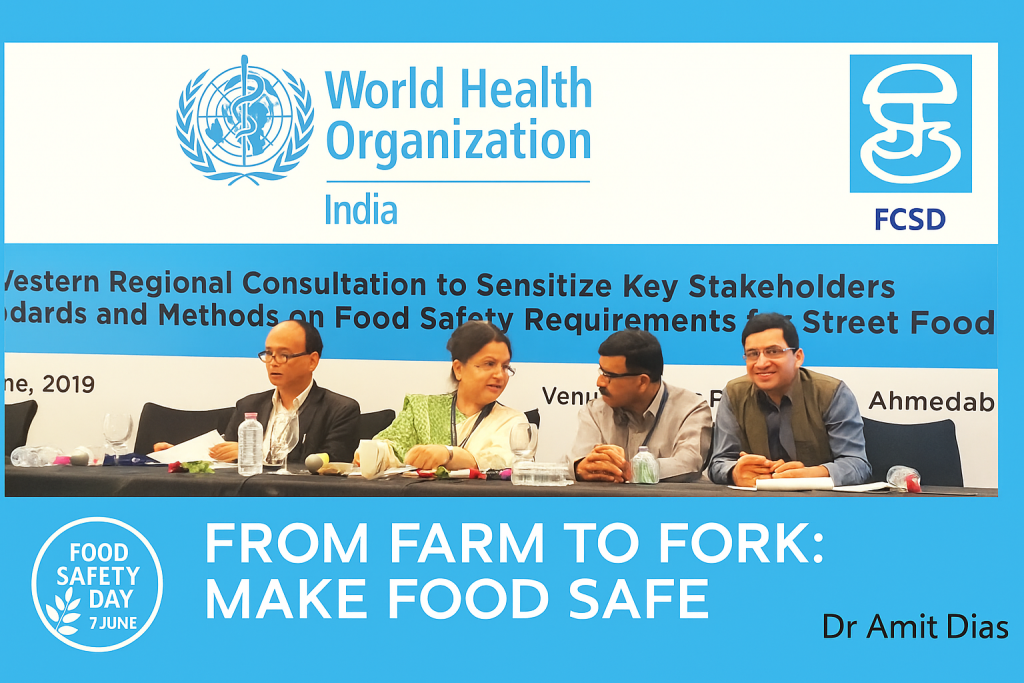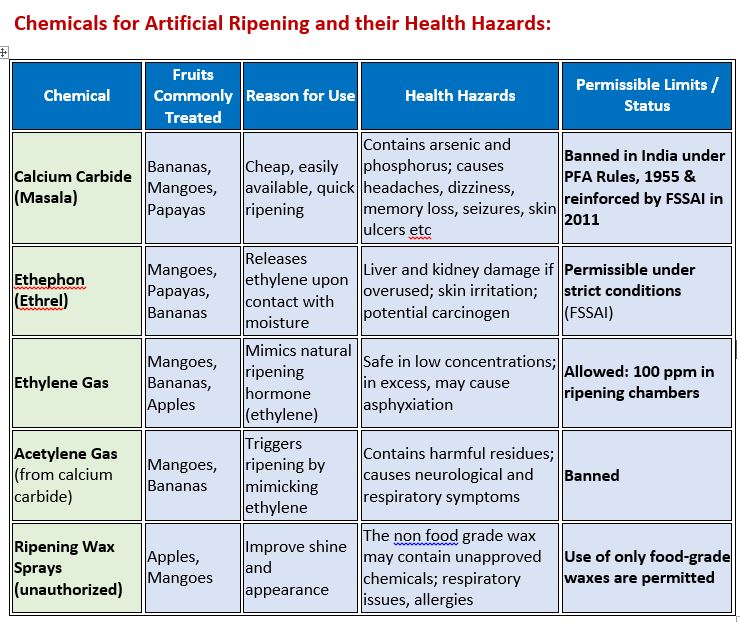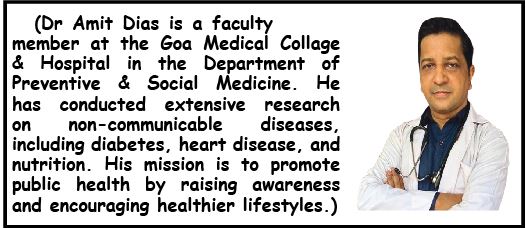Goa is abuzz with excitement as vintage bike and car owners, users, collectors and fans are decking […]

FOOD SAFETY: SCIENCE IN ACTION
June 14- June 20, 2025, MIND & BODY, HEART & SOUL June 13, 2025Food for thought by DR AMIT DIAS on ‘World Food Safety Day’
“If it’s not safe, it’s not food,” says Dr Amit Dias (MD), underscoring the importance of ensuring that every bite we consume is free from contamination, on World Food Safety Day, observed annually on June 7. We took this opportunity to speak to him on this occasion. We have a lot of food for thought here where we learn the key challenges and solutions in food safety today.
Goan Observer: Why is World Food Safety Day significant, especially for the healthcare community?
Dr Amit Dias: Food safety is fundamental to public health, and yet it remains an often overlooked contributor to morbidity and mortality. According to the WHO, unsafe food causes 600 million cases of foodborne illnesses annually, resulting in 420,000 deaths, including 125,000 children under the age of five. The burden is disproportionately higher in low- and middle-income countries, where food safety systems are often fragmented or under-resourced.
This day is a call to put science into practice — to turn data into decisions, and evidence into action. Whether you’re a policymaker, food handler, or physician, journalist — you have a role to play. The Swacha Bharat Abhiyan is a good initiative in this direction.
Q2: You were part of a WHO initiative on developing safe street food systems. What insights can you share?
A2: Street food is an integral part of our culture and economy, especially in urban India — we see stalls selling cutlet pav, bhel puri, pav bhaji, ros-omlet, fast food at every corner of the street. We need to understand that this is also a high-risk environment due to challenges in maintaining hygiene, cold chains, water supply, and waste disposal. We need to encourage such vendors to earn a living, but at the same time provide them with a safe environment and water to maintain sanitation.
The WHO initiative focuses on building safe street food ecosystems. We looked at science-based interventions — from low-cost hand hygiene stations to assessment modules for vendors on food handling, storage and cross-contamination. The aim is to make food safety scalable, sustainable and street-smart. We need to keep our people safe from food borne diseases.
Q3: What are the main foodborne diseases we need to be aware of, and how can they be prevented?
A3: There is a long list of food borne diseases. These illnesses could be caused by bacteria, viruses, parasites, or chemical substances entering the body through contaminated food or water. The most common culprits include Salmonella, E coli, Norovirus, and Campylobacter.”
These can lead to a range of diseases — from diarrheal illnesses, typhoid, hepatitis A and E, to more severe conditions like Guillain-Barré syndrome, linked to Campylobacter, as we saw in the recent outbreak in Pune. We can also get cancer, due to chronic aflatoxin exposure.
To prevent these, we must follow the WHO’s 5 Keys to Safer Food:
- Keep clean
- Separate raw and cooked
- Cook thoroughly
- Keep food at safe temperatures
- Use safe water and raw materials
Good food safety starts from the farm and ends at the plate — it’s a continuum, not an isolated event.
Q4: This year’s theme is Food Safety: Science in Action. How does science help in safeguarding our food?
A4: Science is the backbone of food safety. Whether it’s using whole genome sequencing to trace outbreaks, or biosensors for real-time detection of contaminants, innovation is driving food safety forward. There is a lot happening in this field — risk-based inspection systems, data-driven surveillance networks, and AI-powered food traceability are game changers. Science is not just in the lab. It’s in the soil, the supply chain, and even in your smartphone when you scan a QR code on your food label.
Q5: What precautions should be taken across the food supply chain?
A5: We refer it to as ‘‘From farm to fork’’ – every link in the chain matters — let me break it down for you:
At the farm: Avoid use of untreated sewage, monitor pesticide residues, and implement good agricultural practices.
In processing and transport: Maintain the cold chain, avoid contamination from surfaces, and label items correctly.
In retail and street vending: Ensure hand hygiene, food temperature control, and separation of raw and cooked food.
At home: Wash produce well, don’t thaw at room temperature, cook to safe temperatures, and store leftovers safely.
He cautions against the use of plastic containers for cooking, as toxic leachates can form at high temperatures.
The fancy buzz word these days is “organic food” — but remember that organic food is not necessarily safe. You have to use hygiene practices here as well.
Q6: There’s growing concern about artificially ripened fruits found during the raids conducted recently. What is the problem with this?
A6: I do not have the details on the raids, but there are reports of chemical adulteration — fruits treated with non-food grade wax, dyes, and, most dangerously, calcium carbide for artificial ripening.
Calcium carbide reacts with moisture to produce acetylene gas, which is carcinogenic and also contains impurities like arsenic and phosphorus hydride. It’s banned under the FSSAI regulations. Unfortunately, it’s still used in unregulated markets.
Q7: Is all artificial ripening dangerous? Is anything permissible?
A7: Let me tabulate the details to make it easy to understand.

Q8: So what could be the possible health hazards of eating artificially ripened fruits?
A8: Here are some of them:
Neurological Disorders – Prolonged exposure to arsenic and phosphorus residues from calcium carbide can impair brain function. Calcium Carbide was banned by the PFA rules in 1955 and the ban was reinforced by FSSAI in 2011.
Respiratory Issues – Fumes from acetylene and non-food-grade waxes may lead to bronchitis or asthma.
Gastrointestinal Disturbances – Ingesting chemically ripened fruits may lead to nausea, vomiting, diarrhea, and abdominal pain.
Carcinogenic Risks – Some chemicals like ethephon may break down into harmful compounds like ethylene oxide, a known carcinogen and can lead to cancer.
Liver and Kidney Damage – Chronic exposure to certain chemicals can burden the detoxification organs like the liver and kidneys.
People who use these banned products may not even know about the harm it can cause to the ones who consume the artificially ripened fruits. In fact, chemicals like calcium carbide are also harmful to the vendors who use it.
Q9: What should Consumers do in order to avoid being poisoned by fruits?
A9: Consumers are advised to be “fruit smart”– here is a interesting way to remember what you need to do.
F- Feel the texture – artificially ripened fruits may be too soft or too firm in odd places.
R- Rinse thoroughly – washing fruits well can reduce surface chemical residues.
U- Understand labels – check for certification or ripening details on packaged fruits
I- Inspect for uniformity – overly uniform color may indicate chemical ripening.
T-Trust your nose – naturally ripened fruits have a pleasant, natural aroma.
S-Say no to street shine – Avoid unnaturally glossy or waxy fruits.
Q10: Are there any safe ripening practices?
A10: Here are a few to mention:
Use of Ethylene Gas Chambers: It mimics natural ripening and is safe within prescribed limits.
Temperature & Humidity Control: Ensures uniform and controlled ripening without chemicals.
Certification & Monitoring: Vendors should procure fruits from certified ripening chambers.
Q11: How can medical professionals advocate for food safety?
A11: Doctors and public health professionals are trusted voices. We must educate our patients about safe food practices, report cases of foodborne illnesses and support local food safety initiatives. Nutrition safety education should be integrated with routine consultations and community outreach. But why only doctors? Everyone should help in nutrition education — including journalists. One needs to be aware of the myths and facts of the food safety.
Q 12: What is your final message to our myths and facts of food safety for readers?
A12: Food safety isn’t just about preventing a stomach upset. It’s about protecting generations from long-term harm, building public trust, and upholding the right to safe, nutritious food. This “World Food Safety Day,” let’s champion science, support policy and practice vigilance — because when food is safe, we all thrive.
















